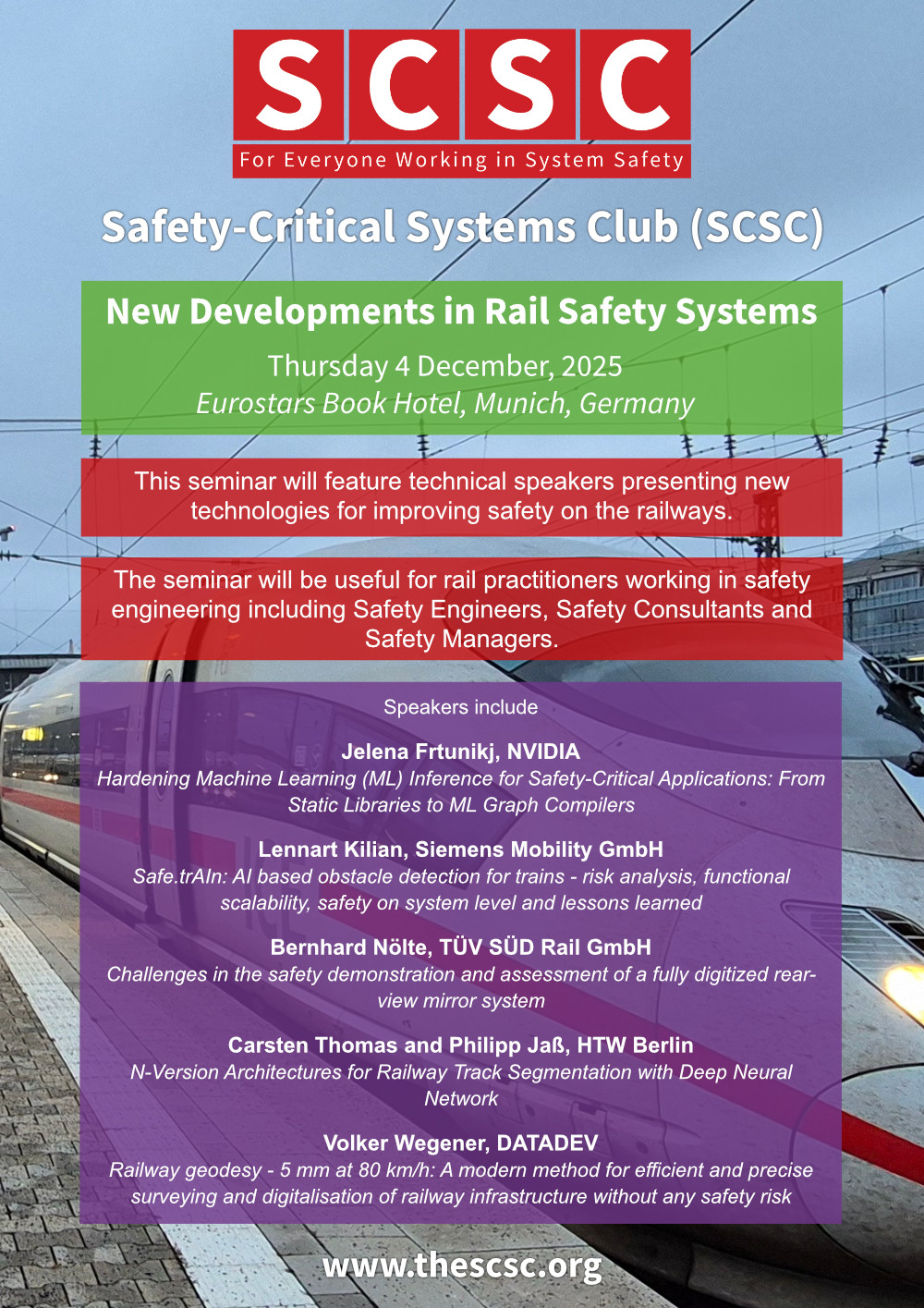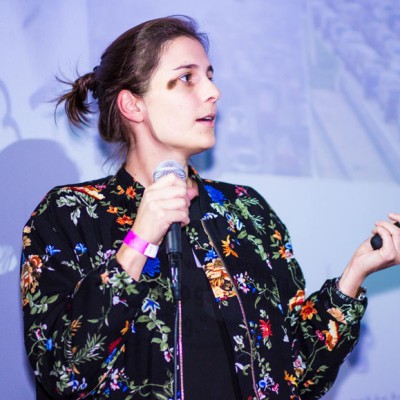Seminar: New Developments in Rail Safety Systems

 New Developments in Rail Safety Systems, is taking place 4th December 2025, at the Eurostars Book Hotel, Munich, Germany.
New Developments in Rail Safety Systems, is taking place 4th December 2025, at the Eurostars Book Hotel, Munich, Germany.
This seminar will feature technical speakers presenting new technologies for improving safety on the railways.
It is aimed at rail practitioners working in safety engineering including Safety Engineers, Safety Consultants and Safety Managers.
Speakers include:
Jelena Frtunikj, NVIDIA - Hardening Machine Learning (ML) Inference for Safety-Critical Applications: From Static Libraries to ML Graph Compilers
Lennart Kilian, Siemens Mobility GmbH - safe.trAIn: AI based obstacle detection for trains - risk analysis, functional scalability, safety on system level and lessons learned
Bernhard Nölte, TÜV SÜD Rail GmbH - Challenges in the safety demonstration and assessment of a fully digitized rear-view mirror system
Carsten Thomas and Philipp Jaß, HTW Berlin - N-Version Architectures for Railway Track Segmentation with Deep Neural Networks
Volker Wegener, DATADEV - Railway geodesy - 5 mm at 80 km/h: A modern method for efficient and precise surveying and digitalisation of railway infrastructure without any safety risk
Abstracts and Bios:
 Jelena Frtunikj, NVIDIA - Hardening Machine Learning (ML) Inference for Safety-Critical Applications: From Static Libraries to ML Graph Compilers
Jelena Frtunikj, NVIDIA - Hardening Machine Learning (ML) Inference for Safety-Critical Applications: From Static Libraries to ML Graph Compilers
Abstract: The evolution of Machine Learning inference represents a paradigm shift from using conventional static kernel library approaches to using complex graph compilers generating custom kernels. This paradigm shift reimagines how we achieve Machine Learning inference in safety critical domains e.g. automotive applications. This presentation examines the transition from traditional development methodologies to next-generation inference architectures that balance performance optimization with rigorous safety validation.
 Lennart Kilian, Siemens Mobility GmbH - safe.trAIn: AI based obstacle detection for trains - risk analysis, functional scalability, safety on system level and lessons learned
Lennart Kilian, Siemens Mobility GmbH - safe.trAIn: AI based obstacle detection for trains - risk analysis, functional scalability, safety on system level and lessons learned
Abstract: The project explored the usage of AI in obstacle detection for highly automated or autonomous regional trains and demonstrated routes to a viable safety case. This includes evaluation of different detectors, definition of a set of AI related safety concerns and evaluation of their mitigation, setups of verification environments and others. The talk introduces the risk analysis including its choice of using a ‘probability of failure on demand’ approach, which lead to controversies some places. Well-designed risk analysis and also functional scalability will be beneficial in course of actual safety cases. The talk will touch the layered approach to safety design, with a skeleton of system level measures, considered important despite the currently limited evaluations. Lessons learned from safety perspective advocate for hands-on understanding and not too complex overall design
Bernhard Nölte, TÜV SÜD Rail GmbH - Challenges in the safety demonstration and assessment of a fully digitized rear-view mirror system
 Carsten Thomas and Philipp Jaß, HTW Berlin - N-Version Architectures for Railway Track Segmentation with Deep Neural Networks
Carsten Thomas and Philipp Jaß, HTW Berlin - N-Version Architectures for Railway Track Segmentation with Deep Neural Networks
 Abstract: To automate safety-critical tasks previously performed by train drivers, autonomous trains require reliable and accurate environmental perception. Current perception systems typically use machine learning (ML) and are subject to performance limitations and assurance challenges. We propose the use of N-version architectures to improve the performance and safety of machine learning (ML)-enabled perception systems. We combine three different neural network architectures in a 3M1I configuration and apply two different prediction combination methods to increase accuracy and to enable error detection: Maximum Confidence Voting (MCV), combining the DNN predictions at image level, and Pixel Majority Voting (PMV), a novel approach for combining the predictions at the pixel level. In addition, we implement a new method for evaluating and combining prediction confidence values in the N-version architecture during runtime. Our results show that N-version architectures improve the detectability of perception errors by utilizing the combined confidence information and enable to enhance perception accuracy by using the PMV combination algorithm. The work showcases how model diversity and adequate voting and combination algorithms can significantly improve the practical applicability of ML-based systems in safety-critical domains such as rail transportation.
Abstract: To automate safety-critical tasks previously performed by train drivers, autonomous trains require reliable and accurate environmental perception. Current perception systems typically use machine learning (ML) and are subject to performance limitations and assurance challenges. We propose the use of N-version architectures to improve the performance and safety of machine learning (ML)-enabled perception systems. We combine three different neural network architectures in a 3M1I configuration and apply two different prediction combination methods to increase accuracy and to enable error detection: Maximum Confidence Voting (MCV), combining the DNN predictions at image level, and Pixel Majority Voting (PMV), a novel approach for combining the predictions at the pixel level. In addition, we implement a new method for evaluating and combining prediction confidence values in the N-version architecture during runtime. Our results show that N-version architectures improve the detectability of perception errors by utilizing the combined confidence information and enable to enhance perception accuracy by using the PMV combination algorithm. The work showcases how model diversity and adequate voting and combination algorithms can significantly improve the practical applicability of ML-based systems in safety-critical domains such as rail transportation.
 Volker Wegener, DATADEV - Railway geodesy - 5 mm at 80 km/h: A modern method for efficient and precise surveying and digitalisation of railway infrastructure without any safety risk
Volker Wegener, DATADEV - Railway geodesy - 5 mm at 80 km/h: A modern method for efficient and precise surveying and digitalisation of railway infrastructure without any safety risk
Abstract: For Deutsche Bahn, up-to-date inventory and condition data on its infrastructure is a strategic tool for achieving its core objectives: safety, efficiency, availability, customer satisfaction, sustainability, and innovation. Precise, digital recording of infrastructure is therefore a key component for the future of rail mobility. Traditional recording methods are reaching their limits due to a shortage of skilled workers, high operational route utilization, and costs. New technologies in vehicle-mounted Multi-Sensor-Systems (MSS; also known as Mobile Mapping systems) are establishing themselves as the key technology for performing measurements during regular train operations with an accuracy of ± 5 millimeters. In addition to the recording technology, innovative solutions for the evaluation and provision of the recorded data are part of the overall solution. This article describes the framework conditions, the process from preparation to recording with MSS to data processing evaluation and digital provision via web technologies. Practical experiences, requirements, and challenges are discussed, with a focus on the use of MSS data for precise measurements in compliance with the strict DB quality standards according to DB Manual 88301 “Track and Construction Surveying” (HB 88301). In addition, two innovative approaches are presented.
The seminar be held at the Eurostars Book Hotel, Schwanthalerstraße 44, 80336 München, Germany, located in the centre of Munich, the Bavarian capital, next to the central railway station (Hauptbahnhof).
This seminar will be conducted in English. All times are Central European Time (CET), one hour ahead of GMT.
This seminar will be held in the normal SCSC format, with registration from 09:30 and talks starting at 10:00 (local time).
The cost will be €315 (€335 including 1-month's SCSC membership) with a student/retired rate of €35
| Schedule | |||||
|---|---|---|---|---|---|
| Registration from 09:00 | |||||
| 09:30 - 09:40 | Mike Parsons SCSC |
Welcome and Introduction | |||
| 09:40 - 10:25 | Lennart Kilian Siemens Mobility GmbH |
safe.trAIn: AI based obstacle detection for trains - risk analysis, functional scalability, safety on system level and lessons learned | |||
| 10:25 - 11:10 | Bernhard Nölte TÜV SÜD Rail GmbH |
Challenges in the safety demonstration and assessment of a fully digitized rear-view mirror system
|
|||
| 11:10 - 11:40 | Coffee | ||||
| 11:40 - 12:25 | Carsten Thomas and Philipp Jaß HTW Berlin |
N-Version Architectures for Railway Track Segmentation with Deep Neural Networks | |||
| 12:25 - 13:25 | Lunch | ||||
| 13:25 - 14:10 | Volker Wegener DATADEV |
Railway geodesy - 5 mm at 80 km/h: A modern method for efficient and precise surveying and digitalisation of railway infrastructure without any safety risk |
|||
| 14:10 - 14:55 | TBA | TBA | |||
| 14:55 - 15:25 | Tea | ||||
| 15:25 - 16:10 | TBA | TBA | |||
| 16:10 - 16:45 | Mike Parsons | Discussion Session | |||
Event Information
| Event Date | 04/12/2025 9:30 am |
| Event End Date | 04/12/2025 5:00 pm |
| Individual Price | €315 (€335 including 1-month's SCSC membership) with a student/retired rate of €35 |
| Location | Eurostars Book Hotel |